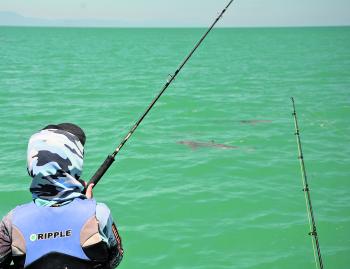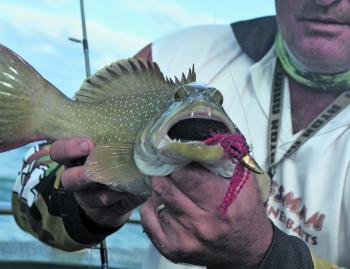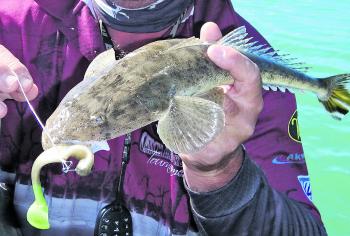Little windows of calm weather between the hectic windy stints have revealed some great fishing to those braving the chop. Most outings haven’t been dangerous, but bloody uncomfortable. The mackerel run is full swing now, and the inshore weed beds, markers and shoal patches are pretty consistent.
Berley has been effective to get a consistent bite, but there is still the odd fish showing up on the troll around birds. Pillies and fish flesh will attract sharks, so use pellets and tuna oil mix. Allow it to wash around at the back of the boat and slowly disperse the slick down current. When mackerel show up, cast lures into the berley trail, or a lightly-weighted pilly, and that should deliver some action. Several trevally species, cobia, queenfish and even schools of small nannies are up in less than three meters of water, so getting a feed is no trouble.
Small to medium wolf herring and chin rigged or skirted gar have been consistent on the Spanish mackerel. White and red head squid skirts have made a difference. Pink is a close second to ‘bling’ your bait up. The use of wire definitely drops the action, and light stainless around 18lb has had the best results. Back off the drag a little when using the light wire, as too firm a setting will pop them.
Big longtail tuna are in and tight packed bait balls on the surface are a pretty good indicator they’re around. Smallish 30gm slugs, or lightly-weighted plastics will effectively get you amongst them. A good technique is to get as close as possible, without spooking them, fire a long a cast right into the action and crank back quickly. If they go down, or you don’t have a casting outfit on board, you can troll a diver around the area to pick them up. Just stay far back from the school and drop your troll line in once you’ve passed the mass, so that your lure passes close to where you saw them. You can spend hours chasing these around with the fly rod, trying to anticipate where they come up next, and you can cover miles trying to intercept them. It’s a pretty exciting fight though, and the efforts are worth it.
Sharks are thick now and anglers are spending a day on the water without being able to land one fish from many hook-ups. Anglers need shark numbers back under control and the problem needs exposure. In water less than a meter deep, we are getting sharked on a regular basis. The remote, untouched reefs are not the only healthy populations, as some might believe.
The initial panic over the Lunds Squid shortage has subsided now, and in Akwa Pro Tackle we have a steady supply that may slightly smaller than the California squid. From all reports, they have been just as successful, so there’s no need to worry. The shortage had some thinking anglers experiment with other options and the results were quite good. Cuttlefish was an option that anglers explored with great results, but lesser known baits, such as half a butterfly-filleted gar, are catching fish too, as anglers look outside the traditional squid box.
Trout, and other bottom dwellers, are making up a fair amount of the catches. If you can get a few aboard before the sharks move in, the shallow offshore reefs are super places to flick a plastic or diver. It’s also easier to beat the sharks there. This is prawn country, and an effective way to chase these shallow water species is to rig them on a 1/2oz head with around a 5/0 hook size. The increased water pressure from the fluffy skirt addition is less streamlined, so the head weight is good for shallows. Once the lure touches down, or nears the reef, start a lift then flick retrieve to get the action started. Be ready to get smacked on the drop and get that head pointing at you fast for the best results.
Whiting, bream and flathead are plentiful targets now the water has cooled considerably. The smallest of plastics are producing the goods here and light head weights are a must for the shallow, less than meter deep water. The Atomic Seekerz 1/11oz heads are very handy when fished on light 4-6lb gear with 6-10lb leaders. Colour wise, the natural shades have been working, but when there’s colour in the water, the brighter colours are pulling more bites. Lures that have been working are the 3” Atomic Prongs, 2.5” Flutter Shrimp from Madeye and the 2” Gulp Shrimp.
The clearer water gives anglers the opportunity to use surface presentations, such as the K9 Atomic walk-the-dog style of stickbaits, and small poppers. Keep the momentum and action up when you see them rise to your lure, and they should follow through on the attack. You’re not imitating a baitfish here, but a prawn, so translucent colours work well, like faded orange. Subtle actions are good, so stickbaits are useful. Work poppers in a horizontal shaking of the rod tip, spit water rather than pop it, and maintain a steady wind to get results.
Jacks and barra are looking for a bit of warmth now and keeping an eye on the temperature gauge can make all the difference. If you happen to be at the mouth of a small drain on a runout tide, then do a u-turn and poke back in the mouth to have a closer look. For snags, traditional hardbodies like the Laser Pro 120, Tilsan Barra and the 85mm Hamma are great. Smaller plastics are even better in deep holes or along ledges, this time of year. A side scan sounder gives a massive head start in finding them, if the snags aren’t producing.
Once you’ve found them, sit back off the school, fire in small plastics up current with enough weight to get the tail bits moving on the descent. Then work it back in slow hops keeping close to the bottom. Use lighter leaders for this style of approach. You’ll lose the odd fish, but your strike rate will increase by a fair margin. You also get a wide range of species with small plastics including grunter, bream, and golden snapper The anticipation of what you’ll catch next is always there.
This time of year can be less predicable, but it’s a pleasure getting out on those cool, calm winter days. It makes you thankful to be a fisher.
1
Ryan Tully with an average sized barra taken on a tiny plastic around a drain mouth.
2
There’s plenty of whiting that mooch around the shallows. This one took a small Gulp! Shrimp, fished lightly, while targeting the barra with Jelly Prawns.
3
The Atomic Prong is well established in lure fishing with good reason. Karl Ramano pulled this sweet trout hopping a ‘green ghost’ – translucent white with the tail dipped in quick coat. It's an awesome combination in clear waters.
4
Some believe that only smaller trout eat plastics, but you’ll be pleasantly surprised at the results.
5
Young Tannhym decided whether or not to throw a lure, as the sharks home in.
6
There have been some epic queenfish getting in on the action. This one came from a school of small mackerel near the river mouth in Townsville.
7
The newly released MadEye Paddle Prawn has really made an impact on reef fishers. The additional skirt goes down well with trout.
8
The Sixth Sense paddle-tail shads are effective lure for a wide range of species and barra are keen as well.
9
Ryan Tully has a golden snapper taken on light gear and an Atomic Prong, rigged with a sinker on the loop knot. Rigging this way helps to avoid snagging, but can reduce your hook-up ratio.
Reads: 1103












